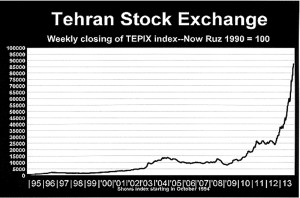January 03-2014

Many foreign media have noted the soaring stock market and attributed it to President Rohani’s election and the start of talks on the nuclear issue. But actually the stunning surge began long before Rohani appeared on the scene.
For a few years, the market was sluggish, with the market level and therefore actually losing value when inflation was taken into account.
But in November 2012, just a few weeks after the rial collapsed, the stock market went into overdrive. It appeared that the public saw stocks as a refuge for cash that was more likely to retain value.
It is true, however, that the market has been spurred even further since Rohani was elected,
The TEPIX, the TSE index, hit a new high on Christmas Day of 88,191. In the six months and 10 days from Rohani’s election in June through Christmas Day, the TEPIX rose a startling 89 percent.
In the six months and 10 days before Rohani’s election, the TEPIX rose 41 percent, which may look small compared to the latest rise but was extremely impressive by any economic measure.
In the six months and 10 days before that (May 25-December 5, 2012) the market rose 23 percent. That included the first weeks of the surge and was enough to beat inflation. In the six months and 10 days before that, however, the TEPIX rose a mere 6 percent, far behind inflation.
More important than the rising index is the funds that are fueling the rising index. According to the TSE, average daily stock trading came to just $20 million in 2006, had risen to $83 million in 2012, but is now up to $203 million a day.
That is a pittance compared to the $220 billion traded each day on US stock markets, but it is very impressive for a country that has had little experience with stock trading.
The huge surge of the last year is not, however, necessarily good. It could represent a bubble that will burst and produce huge losses for investors. In fact, Ramin Rabii, managing director of Turquoise Partners, an investors’ service, is cautioning people that the index is rising “too much, too quickly.” He told Bloomberg News that the gains are “mostly based on sentiment rather than fundamentals.”
Bloomberg also spoke with Samira, a 23-year-old college graduate who was at the exchange watching the trading and preparing to plunk down $600 of savings as her first entry into the stock market. She said she was excited to buy her first shares and would never have done so if Rohani had not taken office.
She said, “I like the feel of this. It has a buzz. Anyone you speak to these days will tell you the stock exchange is the best place to invest right now.”
Rabii said Iranians are withdrawing assets from their traditional storage spots for wealth—gold, dollars and real estate—to get funds to invest in the TSE. (That may, in turn, have helped stabilize the rial against the dollar in the last six months.)
The price-to-earnings (PE) ratio is a traditional measure of value. It shows a stock’s price as a multiple of its earnings. The higher the multiple the better for investors since it suggests the stock will rise even more. Despite the surging stock prices, the Tehran market’s collective PE ratio has actually risen one-third this year to 7.8, according to TSE figures. But Bloomberg said that wasn’t very impressive when compared with the 11.8 PE ratio reported for emerging markets generally by MSCI and the 13.3 figure reported next door on the Qatar stock exchange.
But no one can deny that market prices are booming. The TEPIX passed 10,000 in August 2009. It did not pass 20,000 until January 2011 and 30,000 until October 2012. But since then it has whizzed by 40,000 this year in April, 50,000 in June, 60,000 in August, 70,000 in October, 80,000 in November and it is poised to pass 90,000 shortly.